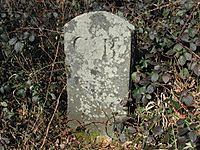Weston Big Wood facts for kids
| Site of Special Scientific Interest | |

One of the "CB" boundary markers found in the wood
|
|
| Area of Search | Avon |
|---|---|
| Coordinates | 51°28′17″N 2°47′10″W / 51.47133°N 2.78604°W |
| Interest | Biological |
| Area | 37.48 hectares (0.3748 km2; 0.1447 sq mi) |
| Notification | 1971 |
Weston Big Wood is a large woodland covering about 37 hectares (that's like 70 football fields!) located west of Portishead in North Somerset, England. It's a special place because it's a nature reserve and also a Site of Special Scientific Interest (SSSI). This means it's protected because of its amazing wildlife and plants. The wood got its name from the nearby village of Weston-in-Gordano.
Contents
Discovering Weston Big Wood's Past
Ancient Origins of the Woodland
Weston Big Wood has been around for a very long time. It dates back at least to the Iron Age, which was thousands of years ago! Some experts even think trees have grown here since the last Ice age, about 10,000 years ago. Imagine how many stories these ancient trees could tell!
Medieval Boundaries and Bristol's Mark
Inside the wood, you can find old stones, ditches, and banks. These are thought to be medieval boundaries from the Middle Ages. People used them to divide the wood into different sections. Later, in 1637, the City of Bristol bought the land nearby. They placed special marker stones with "C.B." (City of Bristol) on them to show their boundary. You can still find these stones today if you look at old maps!
Nearby Quarries and Limestone Ridge
Next to the wood, on its southern side, there's an old, unused quarry called Black Rock. On the western side, near Valley Road, there's another old quarry. This one is now used as a local recycling center. The entire woodland sits on a ridge made of Carboniferous Limestone, which is a type of rock formed millions of years ago.
Plants and Trees of Weston Big Wood
Unique Trees and Rare Flowers
The slopes in Weston Big Wood are home to many Small-leaved lime trees. On flatter areas at the top of the hill, you'll find more oak and hazel trees. There are also some rare whitebeam trees scattered throughout the wood.
This woodland is also special because it has a rare plant called purple gromwell. Other beautiful flowers you might see include wood anemones, violets, and bluebells. Finding plants like herb paris and yellow archangel along with the purple gromwell tells us that this wood is truly ancient.
Animals Living in the Wood
Butterflies and "The Ride"
There's a wide, open area inside the wood called "The Ride." This area was specially created to help butterflies thrive. In summer, you can spot many different kinds of butterflies here. Look out for the orange tip, speckled wood, and purple hairstreak.
Birds and Other Wildlife
Many birds call Weston Big Wood home. You might see woodpeckers tapping on trees, nuthatches climbing headfirst down trunks, and tawny owls hooting at night. Bats also like to roost in the trees. If you see many "setts" (underground tunnels), it means there's a large family of badgers living in the wood!
Visiting and Protecting the Woodland
How to Access Weston Big Wood
There are four main ways to enter Weston Big Wood.
- One entrance is from a small road leading north from the Portishead to Weston in Gordano road, just past the recycling center. It leads up steps to the main circular path.
- Another entrance goes past the old quarries, following a path along the southeastern side of the wood.
- The third entrance is off Underwood Road in Portishead, entering the eastern side of the wood.
- The final entrance is from the fields next to the northern side of the woods.
Once inside, you can follow a circular path that's been marked out for walkers.
Managing This Special Nature Reserve
About 38 hectares of Weston Big Wood are managed as a nature reserve by the Avon Wildlife Trust. They bought this land with help from the Heritage Lottery Fund, the Countryside Agency, and donations from people who care about nature. Their work helps protect this amazing place for everyone to enjoy and for wildlife to thrive.

